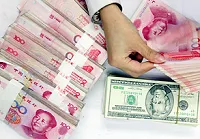
China’s inflation shoots to 34-month high of 5.5% in May
This is due to the higher than expected food inflation which increased to 11.7%.
Here's more from HSBC:
| CPI inflation rebounded to a new cycle-high thanks to higher than expected food inflation and will likely creep up further. The overall economy is moderating with both IP and retail growth softening slightly, but investment demand remains stubbornly strong. There is no signs of over-tightening, in our view. If inflationary pressures are to be meaningfully lowered into 2H, Beijing should keep its foot on the tightening pedal. We continue to expect 100bp reserve ratio and 25bp interest rate hikes in the coming months, if not weeks. Facts The pick-up in headline CPI was due mainly to higher-than-expected food inflation, which rose further to 11.7% y-o-y in May from 11.5% in April. Historically, food prices typically show a sequential decline in May, but a decline of only -0.3% m-o-m was recorded this year due to unfavourable weather conditions and rising pork and egg prices. Meanwhile, non-food inflation picked up to 2.9% y-o-y in May from 2.7% previously, reflecting the pass-through of higher raw material costs and property prices. Residential CPI rose 6.1% y-o-y in May. Producer price inflation surprised the market to the upside by printing the same growth rate as a month earlier of 6.8% y-o-y vs. consensus forecast of 6.5% y-o-y. On a m-o-m basis however, PPI growth eased to 0.3% in May from 0.5% in April. The breakdown suggests that PPI for producer goods and PPI for consumer goods rose at the same %y-o-y pace as before of 7.5%y-o-y and 4.6% y-o-y respectively. Industrial production growth moderated to 13.3% y-o-y in May from 13.4% in April, stronger than market expectations. Seasonally adjusted, m-o-m growth stepped up to 1% in May from 0.9% in April. Within this, growth of heavy industries decelerated to 13.5% y-o-y in May from 14%y-o-y in April, while growth of light industries moderated rebounded to 12.9% y-o-y in May from 11.9%y-o-y in April. As for April, transportation equipment production continued to weaken from 9.7%y-o-y in April to 7.8% y-o-y in May, due to the continuous decline in automobile production. In contrast, growth in the production of electricity rebounded to 12.1% y-o-y in May from 11.7%y-o-y in April, while that of crude steel and steel products accelerated to 7.8% y-o-y and 10.6% y-o-y respectively vs. 7.1% and 8.3% y-o-y in April, reflecting the still strong demand. Retail sales growth eased to 16.9% y-o-y in May from 17.1% y-o-y in April, a touch lower than market expectation of 17%. Seasonally adjusted m-o-m growth rate printed 1.28% in May versus 1.29% in April. In real terms, retail sales growth softened to its slowest in three months at 11.4% y-o-y versus 11.8% y-o-y in April. The biggest surprise came from May's investment growth print. Fixed investment growth accelerated to 25.8% y-o-y for Jan-May, up from 25.4% y-o-y for Jan-Apr. This was notably higher than consensus expectations for 25.2%. The real growth rate for fixed investment subsequently jumped to 18.8% y-o-y in Jan-May, versus with 18.4% Jan-April. Seasonally adjusted, the m-o-m growth rate slowed to 1.02% in May from 1.95% in April. As before, investment at local provincial levels was the driving force behind investment, accelerating to 28% y-o-y in the first five months, compared with 27.4% in the first four months. In contrast, investment at the central government level slowed to 0.3% y-o-y in Jan-May from 2. 6% in Jan-Apr. Sector-wise, the acceleration in investment was led by secondary sectors, the investment growth of which sped up to 26.3% in Jan-May from 24.6% in Jan-Apr. Real estate investment accelerated to 34.6% y-o-y in the first five months, vs 34.3%y-o-y in Jan-Apr - likely as a result of accelerated public housing unit construction. |



![SBR 5 Lorem Ipsum News 2 [8 May]](https://cmg-qa.s3.ap-southeast-1.amazonaws.com/s3fs-public/styles/exclusive_featured_article/public/2025-05/a_hand_pointing_to_a_futuristic_technology_5b87c9d0e3_3.png.webp?itok=M3Hf-9XR)
![SBR 4 Lorem Ipsum [8 May Top Stories]](https://cmg-qa.s3.ap-southeast-1.amazonaws.com/s3fs-public/styles/exclusive_featured_article/public/2025-05/a_hand_pointing_to_a_futuristic_technology_5b87c9d0e3_2.png.webp?itok=2m5Wl0MX)


![Exclusive three SBR 12 Lorem Ipsum [8 May]](https://cmg-qa.s3.ap-southeast-1.amazonaws.com/s3fs-public/styles/exclusive_featured_article/public/2025-05/a_hand_pointing_to_a_futuristic_technology_5b87c9d0e3_11.png.webp?itok=8kn_UIfA)
![SBR 3 Lorem Ipsum [ Exclusive 2]](https://cmg-qa.s3.ap-southeast-1.amazonaws.com/s3fs-public/styles/exclusive_featured_article/public/2025-05/a_hand_pointing_to_a_futuristic_technology_5b87c9d0e3_1.png.webp?itok=YCyjLegJ)
![SBR 2 Lorem Ipsum [8 May]](https://cmg-qa.s3.ap-southeast-1.amazonaws.com/s3fs-public/styles/exclusive_featured_article/public/2025-05/a_hand_pointing_to_a_futuristic_technology_5b87c9d0e3_0.png.webp?itok=_cKD-29o)

![Video [Event News]](https://cmg-qa.s3.ap-southeast-1.amazonaws.com/s3fs-public/styles/event_news_featured_article/public/2025-05/screenshot-2025-05-08-at-4.58.53-pm_0.png.webp?itok=Kud35sMs)
![Event News SBR 9 Lorem Ipsum [8 may]](https://cmg-qa.s3.ap-southeast-1.amazonaws.com/s3fs-public/styles/event_news_thumbnail/public/2025-05/a_hand_pointing_to_a_futuristic_technology_5b87c9d0e3_8.png.webp?itok=DTh_dbYp)
![Event News SBR 9 Lorem Ipsum [8 May]](https://cmg-qa.s3.ap-southeast-1.amazonaws.com/s3fs-public/styles/event_news_thumbnail/public/2025-05/a_hand_pointing_to_a_futuristic_technology_5b87c9d0e3_7.png.webp?itok=vzDAzb6V)
![Event News SBR 8 Lorem Ipsum [8 May]](https://cmg-qa.s3.ap-southeast-1.amazonaws.com/s3fs-public/styles/event_news_thumbnail/public/2025-05/a_hand_pointing_to_a_futuristic_technology_5b87c9d0e3_6.png.webp?itok=jvHFc4P6)
![Video [Event News]](https://cmg-qa.s3.ap-southeast-1.amazonaws.com/s3fs-public/styles/video_thumbnail/public/2025-05/screenshot-2025-05-08-at-4.58.53-pm_0.png.webp?itok=yZnI0YBb)
![Video 1 SBR [8 May]](https://cmg-qa.s3.ap-southeast-1.amazonaws.com/s3fs-public/styles/video_thumbnail/public/2025-05/screenshot-2025-05-08-at-4.58.53-pm.png.webp?itok=9AAeRz_k)

 Advertise
Advertise

